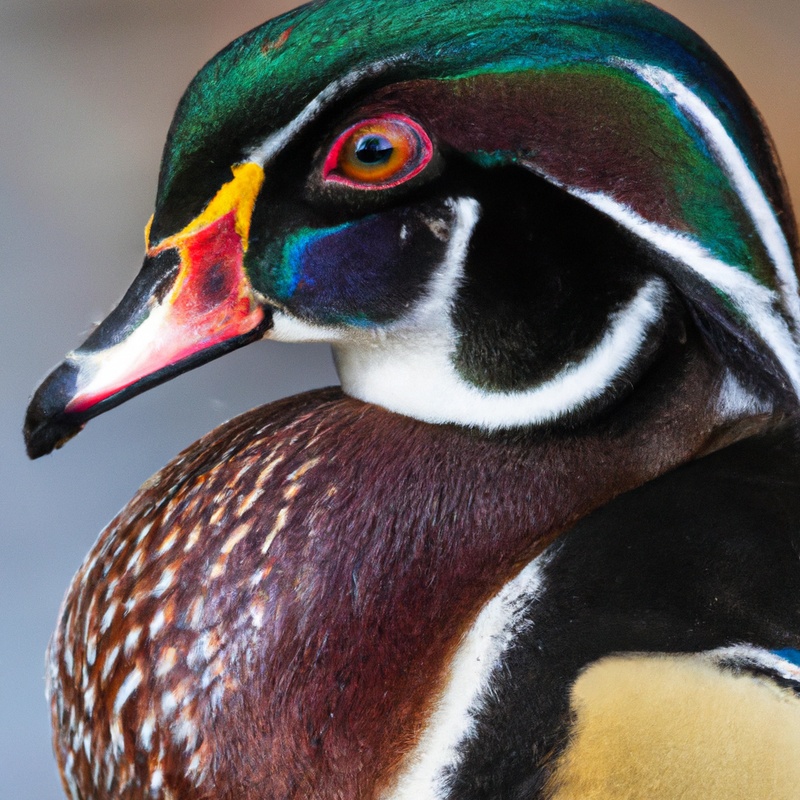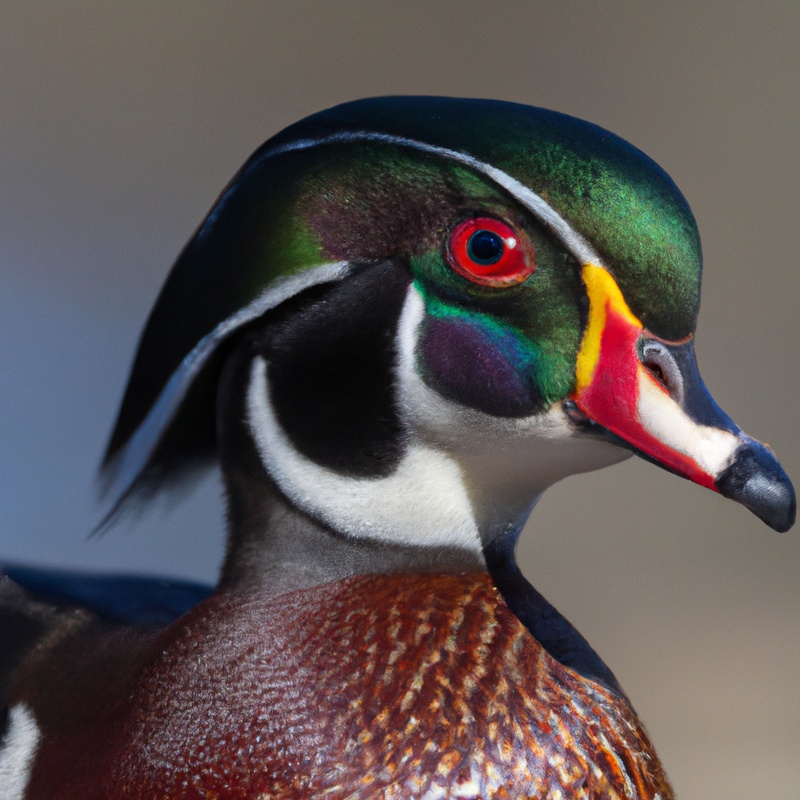Key Takeaways:
- Wood duck hunting is legal in Connecticut.
- Specific regulations and seasons apply for hunting wood duck in the state.
- Connecticut offers hunting opportunities for both residents and non-residents.
- Proper licenses and permits are required for hunting wood duck in Connecticut.
Picture this: it’s a crisp autumn morning, the leaves are ablaze with fiery hues, and there’s a sense of anticipation in the air. You’re nestled in a blind, your heart racing with excitement, as you wait for the distinctive whistle of wings overhead.
Welcome to the world of wood duck hunting in Connecticut, where the thrill of the chase and the beauty of nature collide.
As an experienced hunter with a deep passion for waterfowl, I’m here to guide you through the ins and outs of this exhilarating sport. From the natural habitats and migratory patterns of wood ducks, to hunting regulations and safety considerations, I’ve got you covered.
So grab your gear, and let’s embark on an unforgettable journey into the wild.
Aspect | Information |
|---|---|
Season | September to January |
Bag Limit | 2 per day |
Hunting Method | Shotgun (non-lead ammunition) |
Hunting License | Required for residents and non-residents |
Duck Stamp | Required for all hunters |
Special Regulations | – Hunting allowed only in specified hunting zones – Time limits may apply – Hunters must have a state waterfowl stamp |
Conservation Measures | – Hunters must follow bag limits and shooting hours – Hunting is prohibited in certain areas – The use of lead shot is prohibited |
Wood Ducks in Connecticut
Natural habitat and population of wood ducks in Connecticut
Wood ducks in Connecticut thrive in wetland habitats such as freshwater marshes, swamps, and wooded ponds.
These areas provide the ideal environment for nesting and raising ducklings, with an abundance of vegetation, trees, and water sources.
Connecticut’s wood duck population has been steadily increasing over the years, thanks to conservation efforts focused on preserving and restoring wetland habitats.
These efforts have helped to maintain a healthy population of these beautiful and colorful ducks in the state.
Migratory patterns of wood ducks in the region
Wood ducks in the region follow a predictable migratory pattern.
In the spring, they breed and nest in wetland areas, such as marshes and beaver ponds.
During the summer, they stay close to their nesting sites, raising their ducklings.
As the weather gets colder in the fall, wood ducks begin their migration to more favorable feeding grounds.
They often fly south to find areas with an abundance of seeds and vegetation.
Some wood ducks may travel long distances, while others may only migrate short distances within the region.
The return migration takes place in the spring, when they once again seek out suitable nesting sites.

Hunting Regulations
Licensing and permits required for wood duck hunting in Connecticut
To legally hunt wood ducks in Connecticut, you will need the appropriate licenses and permits. You must have a valid Connecticut Resident or Non-Resident Firearms Hunting License.
Additionally, a Connecticut Migratory Bird Conservation Stamp is required to hunt migratory birds, including wood ducks.
These can be obtained from the Department of Energy and Environmental Protection (DEEP) website or any participating licensing agent. It’s important to always follow the state’s hunting laws and regulations to ensure a safe and legal hunting experience.

Bag limits, season dates, and other regulations to be aware of
Bag limits, season dates, and other regulations are important to understand when hunting wood ducks in Connecticut. The bag limit is set at two wood ducks per day during the early season, from October 2nd to October 30th, and the regular season, from November 7th to January 27th.
It’s crucial to check for any changes in season dates or bag limits each year.
Additionally, hunters must have a valid Connecticut hunting license and a State Waterfowl Stamp. Make sure to familiarize yourself with all other applicable regulations to ensure a safe and legal hunt.

Equipment and Techniques
Recommended firearms and ammunition for wood duck hunting
For wood duck hunting, it is recommended to use a shotgun with a gauge between 12 and 20. A shotgun in these gauges provides enough power to effectively hunt wood ducks without causing excessive damage to the meat.
In terms of ammunition, it is best to use non-toxic shot such as steel or bismuth.
This helps to minimize any negative impact on the environment and comply with regulations. Additionally, using shot sizes ranging from #2 to #4 is suitable for wood duck hunting.
It is advisable to check local regulations and recommendations before going hunting, as they may vary.
Decoy setups and effective calling techniques for attracting wood ducks
Decoy setups and effective calling techniques are key when it comes to attracting wood ducks.
For decoy setups, try using a mix of hen and drake decoys in small groups, mimicking a natural gathering.
Spread them out to create a realistic scene.
Additionally, consider adding motion decoys, such as spinning wings or swimmer decoys, to catch the attention of wood ducks.
When it comes to calling, wood ducks respond well to soft, high-pitched calls.
Use a wood duck call to produce their distinct whistle-like sounds.
Start with a few introductory calls to grab their attention, then mix in feeding calls or comeback calls to simulate activity and draw them closer.
Remember, it’s important to observe and adapt to the behavior of the wood ducks.
Pay attention to their reactions and adjust your decoy setups and calling techniques accordingly.
Tips for finding optimal hunting locations and scouting for wood ducks
When it comes to finding optimal hunting locations and scouting for wood ducks, there are a few tips I can give you. Firstly, pay attention to water sources, as wood ducks prefer shallow wetlands, streams, and ponds.
Secondly, look for areas with vegetation cover, such as flooded timber or marshes, where wood ducks can roost and feed.
Additionally, consider the surrounding habitat, like hardwood forests or agricultural fields, as these can attract wood ducks. Lastly, scout early in the morning or late in the evening when wood ducks are most active.
Remember to be patient and observant, and good luck on your hunt!
Safety Considerations
Importance of firearm safety and responsible hunting practices
Firearm safety and responsible hunting practices are of utmost importance.
To ensure a safe hunting experience, it is crucial to handle firearms with care and follow all safety protocols.
This includes keeping your finger off the trigger until ready to shoot, always pointing the muzzle in a safe direction, and being aware of your surroundings.
Responsible hunting practices also involve obtaining the necessary permits and licenses, respecting hunting regulations, and practicing ethical hunting techniques.
By prioritizing firearm safety and responsible hunting, we can ensure the well-being of ourselves, others, and the environment.
Essential safety equipment and precautions to avoid accidents
Essential safety equipment and precautions are critical when hunting wood ducks in Connecticut. To avoid accidents, there are a few key things you should keep in mind.
Firstly, always wear a fluorescent orange vest or hat to make sure other hunters can see you.
Secondly, carry a reliable, properly secured firearm and only load it when you are ready to shoot. Additionally, use non-toxic shot to protect the environment and lessen the risk of lead poisoning.
Finally, always be aware of your surroundings and communicate with fellow hunters to avoid any dangerous situations.
Stay safe out there!
Tips for a Successful Hunt
Best hunting times and weather conditions for wood duck hunting
Wood duck hunting is most successful during the early morning and late afternoon hours. These times coincide with the ducks’ feeding and flight patterns.
Ideal weather conditions include calm winds, overcast skies, and moderate temperatures.
It is important to note that a light rain can also enhance hunting success, as it encourages the ducks to be more active. Additionally, scouting the hunting location beforehand will allow you to identify areas where wood ducks are likely to be found, increasing your chances of a successful hunt.
Concealment and camouflage strategies for a successful hunt
To have a successful hunt, concealment and camouflage are key.
Here are some strategies to help you blend in with your surroundings and increase your chances of a successful hunt:
- Choose the right camouflage: Pick camouflage patterns that match the environment you’ll be hunting in. Different patterns work better in different settings, so do some research beforehand.
- Break up your silhouette: Use natural cover like bushes or trees to help break up your outline. Avoid standing out against the sky or other open areas.
- Use natural materials: Incorporate natural materials from the hunting area into your camouflage. For example, using local foliage or branches to add depth and texture to your concealment.
- Control movement and sound: Limit unnecessary movement and keep noise to a minimum. Sudden movements or loud noises can alert your targets and ruin your chances of a successful hunt.
- Stay still and patient: Be patient and wait in a concealed position for your prey to come within range. Rushing or constantly changing positions can give away your presence.
Remember, proper concealment and camouflage are essential for a successful hunt.
By blending in with your surroundings, you increase your chances of getting closer to your target without being detected.
Happy hunting!
Tactics for approaching and shooting wood ducks in flight
Approaching and shooting wood ducks in flight requires a combination of stealth, timing, and accuracy. Here are some effective tactics to help you with your hunt:
- Concealment: Use natural cover like bushes, trees, or blinds to hide yourself from the ducks. Avoid making sudden movements or noises that could alert them.
- Decoys: Set up a spread of wood duck decoys to attract their attention and make them more likely to come within range. Place them strategically, mimicking a natural feeding or resting area.
- Call softly: Use soft and realistic wood duck calls to lure the ducks closer. Be mindful of your volume and frequency, as overly loud or constant calling can make them suspicious.
- Be patient: Wood ducks are known for their cautious nature. Wait for the right moment when they’re within range and in a favorable shooting position. Patience is key.
- Lead your shot: When the ducks are in flight, aim slightly ahead of them to compensate for their speed. Practice your shooting skills to improve your accuracy and increase your chances of success.
Remember, wood ducks are agile and can change direction quickly. Stay focused, remain still, and be ready to take your shot when the opportunity arises.
Good luck!
Cleaning and Cooking Wood Ducks
Proper techniques for cleaning and dressing wood ducks
To clean and dress a wood duck, start by plucking the feathers.
Carefully remove the breast meat by cutting along the breastbone.
Make sure to remove any shot pellets that may be present.
Next, remove the legs at the joints.
If desired, you can also keep the wings for cooking or decoration.
Rinse the meat thoroughly and pat dry.
Now you’re ready to cook the duck!
Delicious recipes and cooking methods for preparing wood duck meals
When it comes to preparing wood duck meals, there are various delicious recipes and cooking methods to try. One popular method is to grill the wood duck breast with a simple marinade of olive oil, garlic, and herbs.
You can also pan-sear the duck breast and serve it with a cherry or port wine reduction for a rich and flavorful dish.
Another option is to slow-cook the wood duck in a stew or soup, allowing the flavors to meld together over time. Experiment with different seasonings and ingredients to find your favorite way to cook wood duck.
Frequently Asked Questions (FAQs)
Are there specific areas in Connecticut that are better for wood duck hunting?
Yes, there are specific areas in Connecticut that are better for wood duck hunting.
Here are some popular spots:
- Farmington River: The Farmington River offers ample opportunities for wood duck hunting, especially in the areas upstream of the Collinsville dam. The river’s quiet and secluded stretches provide ideal habitat for wood ducks.
- Housatonic River: Another great location for wood duck hunting is the Housatonic River, particularly in the Kent and Cornwall areas. The river’s diverse wetland habitats attract a significant population of wood ducks.
- Natchaug River: The Natchaug River in Eastern Connecticut is known for its abundance of wood ducks. The river’s forested banks and marshy areas create a suitable environment for these waterfowl.
- Quinebaug River: The Quinebaug River and its associated wetlands, located in the northeastern part of the state, are frequented by wood ducks. Hunters often find success in this area, especially during the early morning and late afternoon.
- Connecticut River: The Connecticut River, running through the heart of the state, offers various opportunities for wood duck hunting. Look for small tributaries and backwaters along the river, where wood ducks are likely to be found.
Remember to obtain the necessary permits and follow all legal regulations when hunting wood ducks in Connecticut.
It’s also important to practice ethical hunting and respect the natural environment.
Can non-residents hunt wood ducks in Connecticut?
Yes, non-residents can hunt wood ducks in Connecticut. However, they are required to obtain a Connecticut Migratory Bird Harvest Information Program (HIP) Permit and a Federal Duck Stamp before hunting.
These permits can be obtained online or through licensed retailers.
It’s important to familiarize yourself with the state’s regulations and limits on bagging and possession of wood ducks. Additionally, make sure you have the necessary licenses and permits to hunt in Connecticut.
Happy hunting!
Can dogs be used in wood duck hunting?
Yes, dogs can be used in wood duck hunting.
They are often trained to retrieve the ducks once they have been shot down.
The dogs can swim out to the fallen ducks and bring them back to the hunter.
This can be especially helpful when hunting in areas with thick vegetation or difficult terrain.
Additionally, dogs can also be trained to help locate and flush out wood ducks, making the hunting experience more successful.
Just make sure to follow all regulations and laws regarding hunting with dogs.
Final Verdict
Hunting wood ducks in Connecticut offers a unique and thrilling experience for outdoor enthusiasts.
With its abundant natural habitat and migratory patterns, the state provides ample opportunities for successful hunts.
However, it is crucial to be well-informed about the hunting regulations and follow responsible practices to ensure safety and conservation.
With the right equipment, techniques, and knowledge of optimal hunting locations, hunters can increase their chances of a successful hunt.
And once the ducks are harvested, proper cleaning and cooking techniques can result in delicious meals.
Whether you are a seasoned hunter or a beginner, wood duck hunting in Connecticut can be a rewarding and enjoyable pursuit.
Overall, this article aimed to provide comprehensive information and insights, backed by expertise, to assist hunters in their wood duck hunting endeavors in Connecticut.









